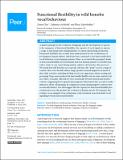Files in this item
Functional flexibility in wild bonobo vocal behaviour
Item metadata
| dc.contributor.author | Clay, Susanna Elizabeth Valerie | |
| dc.contributor.author | Archbold, Jahmaira | |
| dc.contributor.author | Zuberbuehler, Klaus | |
| dc.date.accessioned | 2015-09-25T09:10:05Z | |
| dc.date.available | 2015-09-25T09:10:05Z | |
| dc.date.issued | 2015-08-04 | |
| dc.identifier | 219297087 | |
| dc.identifier | c5eab09e-68eb-4efd-a8e6-60acfffbb735 | |
| dc.identifier | 84940379207 | |
| dc.identifier | 000360844000006 | |
| dc.identifier.citation | Clay , S E V , Archbold , J & Zuberbuehler , K 2015 , ' Functional flexibility in wild bonobo vocal behaviour ' , PeerJ . https://doi.org/10.7717/peerj.1124 | en |
| dc.identifier.issn | 2167-8359 | |
| dc.identifier.other | ORCID: /0000-0001-8378-088X/work/64360758 | |
| dc.identifier.uri | https://hdl.handle.net/10023/7539 | |
| dc.description | This research was financially supported by the L.S.B. Leakey Foundation, the National Geographic Society: Committee for Research and Exploration Grant, the British Academy Small Research Grant, the European Union Seventh Framework Programme for research, technological development, and demonstration under grant agreement 283871 and private donors associated with the British Academy and the Leakey Foundation. | en |
| dc.description.abstract | A shared principle in the evolution of language and the development of speech is the emergence of functional flexibility, the capacity of vocal signals to express a range of emotional states independently of context and biological function. Functional flexibility has recently been demonstrated in the vocalisations of pre-linguistic human infants, which has been contrasted to the functionally fixed vocal behaviour of non-human primates. Here, we revisited the presumed chasm in functional flexibility between human and non-human primate vocal behaviour, with a study on our closest living primate relatives, the bonobo (Pan paniscus). We found that wild bonobos use a specific call type (the “peep”) across a range of contexts that cover the full valence range (positive-neutral-negative) in much of their daily activities, including feeding, travel, rest, aggression, alarm, nesting and grooming. Peeps were produced in functionally flexible ways in some contexts, but not others. Crucially, calls did not vary acoustically between neutral and positive contexts, suggesting that recipients take pragmatic information into account to make inferences about call meaning. In comparison, peeps during negative contexts were acoustically distinct. Our data suggest that the capacity for functional flexibility has evolutionary roots that predate the evolution of human speech. We interpret this evidence as an example of an evolutionary early transition away from fixed vocal signalling towards functional flexibility. | |
| dc.format.extent | 5570952 | |
| dc.language.iso | eng | |
| dc.relation.ispartof | PeerJ | en |
| dc.subject | Vocal development | en |
| dc.subject | Speech evolution | en |
| dc.subject | Great ape | en |
| dc.subject | Pre-linguistic infant | en |
| dc.subject | Emotion valence | en |
| dc.subject | Vocal flexibility | en |
| dc.subject | Primate | en |
| dc.subject | Language evolution | en |
| dc.subject | Protophone | en |
| dc.subject | QL Zoology | en |
| dc.subject | GN Anthropology | en |
| dc.subject | BF Psychology | en |
| dc.subject | NDAS | en |
| dc.subject.lcc | QL | en |
| dc.subject.lcc | GN | en |
| dc.subject.lcc | BF | en |
| dc.title | Functional flexibility in wild bonobo vocal behaviour | en |
| dc.type | Journal article | en |
| dc.contributor.institution | University of St Andrews. School of Psychology and Neuroscience | en |
| dc.contributor.institution | University of St Andrews. Institute of Behavioural and Neural Sciences | en |
| dc.contributor.institution | University of St Andrews. Centre for Social Learning & Cognitive Evolution | en |
| dc.identifier.doi | https://doi.org/10.7717/peerj.1124 | |
| dc.description.status | Peer reviewed | en |
| dc.identifier.url | https://peerj.com/articles/1124/#supplemental-information | en |
This item appears in the following Collection(s)
Items in the St Andrews Research Repository are protected by copyright, with all rights reserved, unless otherwise indicated.

